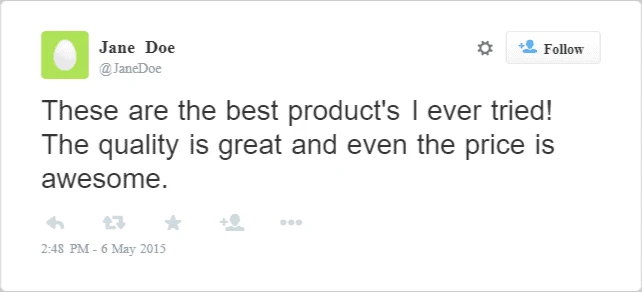You might think sentiment analysis is for stock market investors or other finance-oriented people but it has many interesting applications in digital marketing. What’s more – with a spread of machine learning algorithms – this type of analysis is more accurate than ever and available to anyone in every price range. Let’s take a look at what it really is, why to use it, how to use it, and what tools to use.
What is sentiment analysis
Sentiment Analysis is also known as opinion mining. It’s an automated text analysis technique used to extract aggregated emotional information from the given text. In other words, it’s used to analyze the emotions of the comments, opinions, user feedback, or any other data set.
These different text quotes are the input, we’ll talk about them in detail later. What is the output? It’s different based on the tools & algorithms you use.
It can be a prediction of the emotional state of the author like “sad”, “happy” “angry” etc. Or the overtone (positive, negative, neutral). It can be shown as a simple status or deliver the intensity information (like 35% happy, 65% curious).
Although – and this is extremely important – sentiment analysis algorithms are better and better, they are not perfect. So in the most important cases, it’s crucial to support it with human analysis. Let’s take a look at a few examples of how the sentiment analysis works and some of the troublesome opinions.
How sentiment analysis work
This part will be, of course, simplified because the purpose of this article is to present marketing applications, not to dwell on technical details. Some level of understanding will be helpful though.
In “the old days” the analysis was based on the if/else rules. For example, if the analyzed text contained a curse word or other obviously negative keywords it is definitely negative and its author is angry.

If it contains words like “awesome” or “great” – it’s with a high probability a positive opinion from someone relatively happy.

So it was all based on keywords and even if the rules were much more advanced than what I presented here it was still far from perfect.
However, the machine learning algorithms improved these methods and the accuracy significantly. The core is no longer human-generated rules but the patterns the algorithms discovered itself and the whole context of the discussion is considerate too.
That’s why even opinions like this may be correctly identified as negative even if they contain the seemingly positive keyword.

With large datasets, algorithms can analyze to learn their accuracy may reach 90%+ levels which is still not perfect and maybe never be but it’s enough to rely on in most cases.
There are some other challenges still. Other languages than English may have lower accuracy. English is definitely the most popular language for creators of sentiment analysis tools. Besides, people use all sorts of contradictions, jokes, abbreviations, language mix, and other techniques that may fool the algorithms. That being said I hope you are still interested in how to use these methods for your marketing.
Why use sentiment analysis?
1. Understand your audience
No matter if you are a social media manager, a product marketer, a copywriter, or a performance marketing manager – the more insights you have from your audience – the better you’ll be able to do your job. Thanks to the sentiment analysis you can better understand your audience, learn what they like and dislike, and adjust your message based on this information.
2. Analyze your reputation
How did your customers respond to the recent product release? What do they think of your pricing or customer service? Which features of your offer they like and dislike the most? Learn all of that using sentiment analysis data. You’ll be able to craft your communication better and strengthen your reputation. And better reputation means more recommendations and more clients.
3. Compare with competitors
Data out of context doesn’t mean much. If you have 75% of positive opinions – is it good or bad? Hard to say but you can analyze these numbers with your competitors or other brands from your segment and see how good your opinions are and where you still have the potential for improvement.

4. Measure your marketing / PR efforts
Sadly, not everything in marketing may be measured but sentiment analysis may be a nice addition to your KPIs. Especially public relations activities may be hard to analyze because they rarely generate customers directly. But positive mentions from your customers or followers or journalists is something worth tracking to see the benefits from these activities.
5. Detect potential crisis
Every business has dissatisfied customers. And sometimes they have every right to be angry if you or someone from your team made a mistake. The fastest you react the less damage you’ll take from such a situation. Sentiment analysis can help you to detect the most negative/angry comments more quickly and you’ll be able to react respectively before the emotion escalates.
6. Scan influencers / contrahents
You are about to start a new cooperation with a social media influencer? It may be beneficial but at the same time, it’s not hard to imagine how it may backfire because of a big negative audience some influencers have. You can analyze the language of the influencer (and about them) and their followers and automatically detect what range of emotions they usually generate and if these emotions fit your brand image.

You can also utilize an influencer search platform that allows you to filter through social media influencers in order to find the right fit for your campaign.
7. Market research
Do you plan a new marketing campaign around the controversial topic? Or a new real-time Facebook post about the new hot event? Analyze the emotion around these discussions to make sure it’s something you want to be included in. Also, if you want to enter a new market or release a new product – sentiment analysis should be a part of your market research to inform your decisions.
8. Support employer branding
Your recruitment costs and effectiveness highly rely on the opinions about your business. Analyze the emotions related to your brand on opinion forums or from your applicants and see if your online presence supports your recruitment campaigns or on the contrary – maybe people are discouraged by what they read about your business in Google.
Which sources should you analyze?
As you can see it’s all about the customer feedback and your brand/product perception in the media. Therefore in my opinion there are 3 main source types you can focus on.
1. Conversations with your customers
Wherever you talk to the customers – this is a great source to analyze. Your Customers Relationship Management systems, emails, calls, or even Facebook Messenger. Archive all of these conversations and analyze their sentiment to get a full image of your audience’s emotions.
2. Social media
There are literally thousands of articles and books on how important social media are so if you and your customers are present in at least one of the channels I probably don’t have to convince you this may be a great source of discussions you can analyze.

3. Other media
Getting data from other media (like online forums, blogs, TV, or newspapers) and analyzing them may be more difficult and probably it might be hard to get any brand mentions from other media because most conversations take place on Facebook, Twitter and others. However, the quality of data may be higher here. Especially if you work with journalists or you work on a big brand that is often mentioned in offline media.
I believe businesses of any size may benefit from sentiment analysis. If your brand is relatively small you will probably focus on opinions from your customers and maybe from social media. If you work for a big company with a popular brand and many areas of interest – you probably should analyze the data from all possible sources and monitor the trends.
How to analyze sentiment?
Again, there are a few options you can try.
1. Hire a specialist
You can try to develop your own tool to scrape the data from the sources you are interested in and use the AI to analyze them. It will be expensive and take months but you’ll create something especially for your needs.
2. Use online tools and services
There are many tools offering sentiment analysis from several dozen $ per month and also many agencies who can help you filter the data and present actionable insights based on that.
Two of my favorites are:
-
Brand24 – online media monitoring tool with sentiment analysis. It will help you to collect online mentions for any topic you want and mark these data as “positive” “negative” or “neutral”.
-
Prodsight – customer feedback intelligence tool with sentiment analysis. This one you can integrate with your CRM and App Store and analyze direct feedback from customers.
3. Talk to us
In Hire Digital, we can help you with a variety of your marketing needs with the help of top talents from around the world. Prepare your digital marketing strategy including sentiment analysis with Hire Digital’s exclusive network. Rigorously screened talents are ready for your most important projects to hire within 2 days.
We hope you found some useful tips in this article and it will help you to better understand your audience’s emotions.
We wish you high conversion rates and let’s talk soon!
